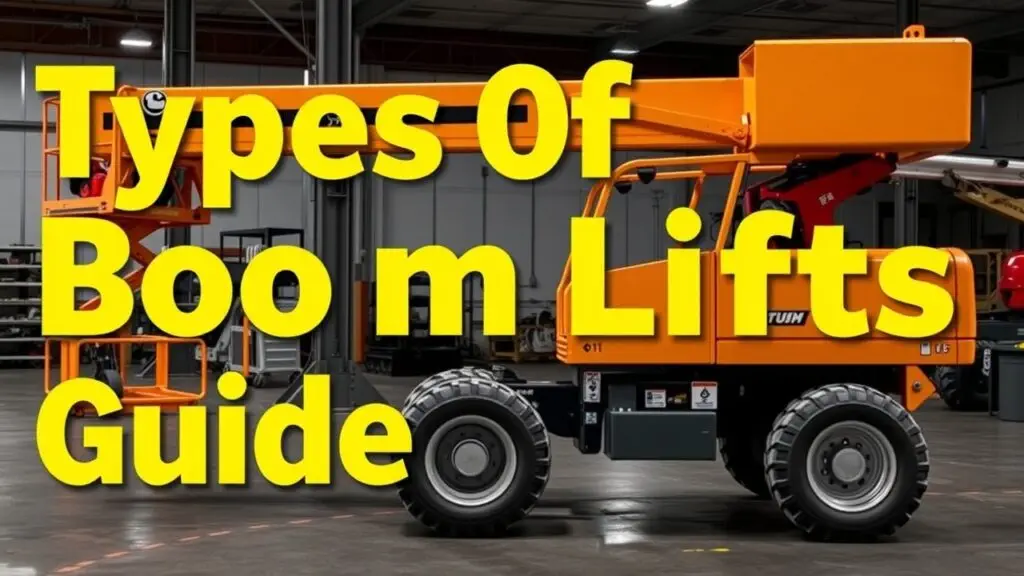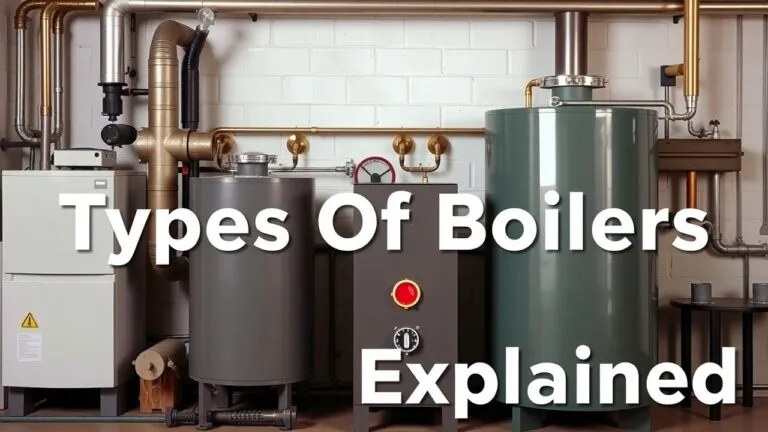Discover the types of boom lifts. Choosing the right boom lift depends on reach, maneuverability, and worksite conditions. This guide compares articulating, telescopic, and other aerial lifts to help you decide.
What Are Boom Lifts?

Boom lifts are special machines that help lift people and materials high into the air. They are super useful in construction, maintenance, and other jobs where you need to reach high places. You might hear them called aerial work platforms (AWPs). There are different kinds of boom lifts designed for various tasks.
The two main types are articulating boom lifts and telescopic boom lifts.
- Articulating Boom Lifts: These lifts can bend at joints. This makes them great for reaching over things or getting into tight spots. They can easily move around buildings or other structures.
- Telescopic Boom Lifts: Also known as straight boom lifts, these have long arms that extend straight out. They can reach much higher but are not as good at going around obstacles like articulating models.
You might also hear the term “cherry picker.” This often refers to smaller versions of boom lifts used for lighter jobs like tree trimming or fixing power lines.
Knowing about the types of boom lifts helps you pick the right one for your needs.
Why Is Choosing the Right Boom Lift Important?
Picking the right boom lift is very important for safety and getting work done well. Using the wrong lift can lead to accidents, which is dangerous for workers. When you choose the right machine, it can make your job easier and quicker while saving money.
Here are some key things to think about when choosing a boom lift:
- Reach Height: How high do you need to go? This helps you choose the right lift.
- Weight Capacity: Make sure the lift can carry both workers and materials safely.
- Job Site Conditions: Are you working inside or outside? Is the ground smooth or bumpy?
- Safety Features: Look for things like guardrails, emergency stop buttons, and stability controls.
By looking at these factors carefully before making a choice, operators can find a machine that follows safety rules while also boosting efficiency on the job site.
Types of Boom Lifts Explained
Articulating Boom Lifts (Knuckle Boom)
Articulating boom lifts, also called knuckle boom lifts, have hinged sections. This feature lets them reach in different directions. They can move around obstacles easily, both up and sideways. This makes them very useful for many types of work.
Key Features:
These lifts are great in tight spots. They can easily go around barriers or structures. This makes them perfect for indoor jobs like fixing lights in warehouses and outdoor tasks like landscaping where there are things in the way.
Common Applications:
Articulating boom lifts work well where you need flexibility. Some common uses include:
- Indoor maintenance in warehouses
- Outdoor projects around buildings or other structures
Advantages vs Disadvantages:
The big plus of these lifts is their flexibility. They can get to hard-to-reach places. But they usually don’t go as high as telescopic models.
Telescopic Boom Lifts (Stick Booms)
Telescopic boom lifts, or stick booms, stretch straight up. They are built for high-reaching jobs. This design is good for tasks that need direct access without anything blocking the way.
Key Features:
These lifts have top-notch vertical reach capabilities compared to other lifts. Their structure allows operators to extend straight up, making them ideal for:
- High-rise building maintenance
- Outdoor construction projects that need height
Common Applications:
You will find telescopic boom lifts often used for high buildings and various outdoor construction projects needing tall heights.
Advantages vs Disadvantages:
While they can reach higher than articulating boom lifts, their downside is that they are not as flexible when going around things because of their straight extension design.
Combination Models (Hybrid Designs)
Combination models mix the best parts of both articulating and telescoping designs into one machine. These hybrid designs provide:
- Articulated flexibility
- Telescoping height advantages
This makes them great for different kinds of jobs indoors and outdoors, allowing workers to use one machine instead of two.
In short, knowing the types of boom lifts helps you choose the right one based on your project needs, like whether you need to be able to move around easily or reach high places.
Key Specifications to Consider
When you pick a boom lift for your work, you should think about some key specs. These include the height and reach of the lift. You need to make sure it can handle the tasks you have. The boom lift height is very important. It needs to safely support both people and tools at the heights you need. Also, checking the platform size is smart because it shows how much room you have for workers and equipment.
Another thing to look at is the weight capacity. This tells you how much load the boom lift can safely lift, including people and gear. Always check this before making a choice.
You should also think about the power source—electric or diesel. Electric boom lifts are usually quieter and better for the environment, but they may not last as long as diesel ones, which are stronger for outdoor work.
Other features like outrigger systems give stability on uneven ground. Plus, jib extensions help reach tricky spots. Telescoping sections provide extra height when needed, especially useful in tall buildings.
Here’s a simple table of key specifications to think about:
| Specification | Description |
|---|---|
| Boom Lift Height | Maximum height it can reach |
| Reach | Distance it can stretch horizontally |
| Platform Size | Size of the working area |
| Weight Capacity | Maximum load limit |
| Power Source | Type (electric, diesel) |
| Outrigger Systems | Tools for stability on uneven surfaces |
| Jib Extensions | Extra arm for hard-to-reach places |
| Telescoping Sections | Additional vertical reach |
Knowing these details helps you choose the right boom lift for your job while keeping everyone safe.
Comparing Articulating and Telescopic Boom Lifts
To decide between articulating and telescopic boom lifts, it helps to compare them. Here’s a simple table showing their main differences:
- Reach: How high each type goes
- Capacity: How much weight they can hold
- Maneuverability: How well they can move around obstacles
- Cost Efficiency: Renting versus buying options
Articulating boom lifts are great in tight spaces because they have a special design that bends. But they might not go as high as telescopic boom lifts, which can reach way up in the air. They are better for high buildings.
Understanding these differences helps you make a good choice based on what you need and how much money you want to spend.
Industry-Specific Applications

Boom lifts are super important tools in many jobs. They help people reach high spots safely. Knowing how to use different boom lifts can help you pick the right one for your needs.
Construction Boom Lifts
In construction, boom lifts are must-have tools. They help workers get to high places easily and safely. This makes building maintenance, installing structures, and inspections a lot easier. There are two main types of boom lifts used in construction: articulating and telescopic. Articulating boom lifts have jointed arms. They can move around obstacles on job sites. Telescopic boom lifts go straight up and work best for reaching very high spots directly.
Maintenance Boom Lifts
When it comes to maintenance work, getting to hard-to-reach areas is key. Maintenance boom lifts make this easy in warehouses or factories. These lifts let workers fix things without needing ladders or scaffolding. They provide a safe spot to reach things like lights or air conditioning systems that are up high.
Landscaping Boom Lifts
Landscaping often includes tree trimming and other outdoor tasks that need height access. Landscaping boom lifts are perfect for safely pruning trees or setting up lights in tall plants. They can even fit into tight spaces, which is great for smaller yards.
Industrial Manufacturing Boom Lifts
In factories, these aerial platforms help with moving materials and setting up assembly lines when height matters. Industrial lift models can hold heavy things while staying steady at high spots. This is really important when working with machines or big shelves in warehouses.
Telecommunications Boom Lifts
Companies that deal with telecommunications depend on aerial work platforms to maintain power lines and install communication towers. These special boom lifts have the reach and stability needed to work near electrical lines or check on tall structures regularly.
Task-Specific Applications
Different jobs need specific tools based on what they require for safety and function.
Painting with Boom Lifts
When painting from up high, using an elevated work platform helps keep the process safe and effective across large areas.
Welding and Fabrication Tasks
Welding projects often happen at heights, so height safety equipment is key when using any lifting device like a boom lift made for fabrication.
Inspections Using Aerial Work Platforms
Job site safety is super important during inspections; using reliable aerial work platforms makes it easier for inspectors to get where they need while keeping everything safe.
Cleaning High Areas
Cleaning hard-to-reach ceilings needs fall protection systems along with good cleaning tools made for those tough spots. Choosing the right model is very important!
Signage Installation Techniques
For businesses putting up signs way above people’s heads, investing in the right lift options is really smart!
Tree Trimming Methods
Tree trimming works better with spider-lift technology that gives operators more control when making cuts on branches that stretch out far!
Selecting the Right Boom Lift
Factors Influencing Boom Lift Choice
When picking a boom lift, think about several key factors. Knowing these can help you find the right machine for your job.
Worksite Conditions: Where you use the boom lift matters. Indoor lifts are great for tight spaces. If you’re outside, choose a model that can handle wind and rough ground. Look out for trees or buildings that might get in your way.
Terrain and Obstacles: Some places have rough terrain. If your site has gravel, mud, or steep areas, you’ll need a lift made for those conditions. Certain lifts have special tires or stabilizers that help keep them steady on uneven surfaces.
Required Reach/Capacity
It’s important to know the difference between vertical reach and horizontal outreach when choosing a boom lift. Vertical reach tells you how high it can go, while horizontal outreach shows how far it can extend from its base. Depending on what you need—like reaching high places in warehouses or going over obstacles—pick the right one.
Budget Constraints
Your budget is a big deal when deciding whether to buy or rent a boom lift. Buying means spending a lot upfront, but it could save money if you use it often. Renting is cheaper at first but might cost more in the long run if you need it for many jobs. Think carefully about both options based on how much you’ll use the lift.
Operator Experience Level
Who operates the lift matters too! Make sure operators are well-trained. They should understand how to control the machine and know safety rules and emergency procedures for each type of boom lift.
Safety Regulations
Safety rules are super important when picking lifting gear. Check out OSHA regulations that relate to workplace safety for aerial lifts. This includes knowing about fall protection systems that keep everyone safe during operations.
Step-by-Step Selection Guide
- Assess Project Needs
First, outline your project’s height and weight requirements. - Evaluate Site Conditions
Look at the terrain and possible hazards where you will work. - Determine Budget
Decide if it’s smarter to buy or rent based on your financial plan. - Research Equipment Options
Check different models available, like articulating or telescopic lifts that fit your needs. - Review Safety Standards
Make sure everything meets safety regulations like OSHA guidelines before making your choice. - Consult Experts if Necessary
Ask advice from equipment dealers or industry pros to find suitable options for your projects.
Boom Lift Safety and Maintenance
Essential Safety Features
When using boom lifts, safety is super important. There are some key safety features that help keep operators and workers safe.
- Emergency Controls: These buttons let operators stop or lower the lift quickly in an emergency.
- Load Capacity Indicator: This shows how much weight the lift can safely carry, which helps avoid overloads that can cause accidents.
- Fall Protection: Many boom lifts have guardrails and spots to attach safety harnesses. These keep workers secure while they work up high.
- Personal Protective Equipment (PPE): Operators must wear the right PPE, like helmets and gloves, when working at heights.
- Outriggers: Some boom lifts have outriggers that extend from the base. These provide extra stability when operating.
These features are very important for keeping everyone safe when using aerial lifts.
Safe Operating Procedures
Following the right procedures is key for staying safe with boom lifts:
- Pre-operational Checks: Before using a boom lift, operators should check it carefully to make sure everything works properly.
- Operator Training Requirements: Only trained people should use boom lifts. This training includes knowing how to use controls and spotting hazards.
- Load Limits: Always stick to the load limits given by the manufacturer. This prevents tipping or breaking parts of the lift.
- Emergency Procedures: Operators should know what to do in case of a malfunction or accident.
By following these rules, users can lower the risks tied to operating boom lifts.
Regular Maintenance and Inspections
Regular maintenance keeps boom lifts safe and working well:
- Boom Lift Maintenance Schedule: Sticking to a maintenance schedule helps find problems before they get worse.
- Boom Lift Inspection Checklist:
- Check for hydraulic leaks
- Look over electrical parts
- Make sure all safety devices work
- Common Issues with Boom Lifts:
- Hydraulic fluid leaks
- Electrical problems
- Worn-out tires or tracks
Fixing any problems quickly helps keep equipment running well.
Knowing about essential safety features, following safe procedures, and keeping up with regular maintenance are important for managing boom lifts effectively in construction sites.
Frequently Asked Questions (FAQs)
What are track-drive boom lifts?
Track-drive boom lifts have tracks instead of wheels. These lifts work well on rough or uneven terrain. They provide stability and maneuverability in tough job sites.
What are towable boom lifts?
Towable boom lifts are lightweight and can be towed by a vehicle. They are easy to transport and ideal for short-term jobs. They can reach high places with ease.
What are self-propelled boom lifts?
Self-propelled boom lifts move independently without towing. They come with controls that allow operators to navigate easily on job sites. These lifts offer flexibility for various applications.
What are rough terrain boom lifts?
Rough terrain boom lifts have larger tires and better traction. They work well in outdoor conditions like gravel or mud. These lifts provide stability when navigating challenging surfaces.
How do I choose between electric and diesel boom lifts?
Electric boom lifts are quieter and ideal for indoor work. Diesel models perform better outdoors and on rough sites. Consider your work environment before making a choice.
What safety features should I check for in a boom lift?
Look for emergency controls, load capacity indicators, and fall protection systems. Check for features like guardrails and harness points as well. These enhance worker safety while using the lift.
Additional Considerations When Choosing a Boom Lift
- Platform Capacity: Ensure it can hold the required weight.
- Power Source: Decide between electric, diesel, or battery-powered options.
- Control Types: Consider joystick vs. remote control setups.
- Stability Features: Look for outriggers or counterweights.
- Accessibility Options: Check if it fits through narrow spaces.
- Maneuverability: Assess its turning radius for tight areas.
- Manufacturer Reputation: Research brands like Haulotte, Skyjack, and Snorkel for reliability.
This helps you select the best equipment based on your project needs and working conditions.
Related Topics
- types of aerial work platforms (AWPs)
- types of power sources for boom lifts (electric vs. diesel)
- types of boom lift drive systems (track, towable, self-propelled)
- types of terrain for boom lift use (rough terrain vs. smooth)
- types of boom lift control systems (joystick vs. remote)
- types of safety features for boom lifts
- types of boom lift manufacturers



Types of Boom Lifts: A Guide to Choosing the Right Lift for Your Needs